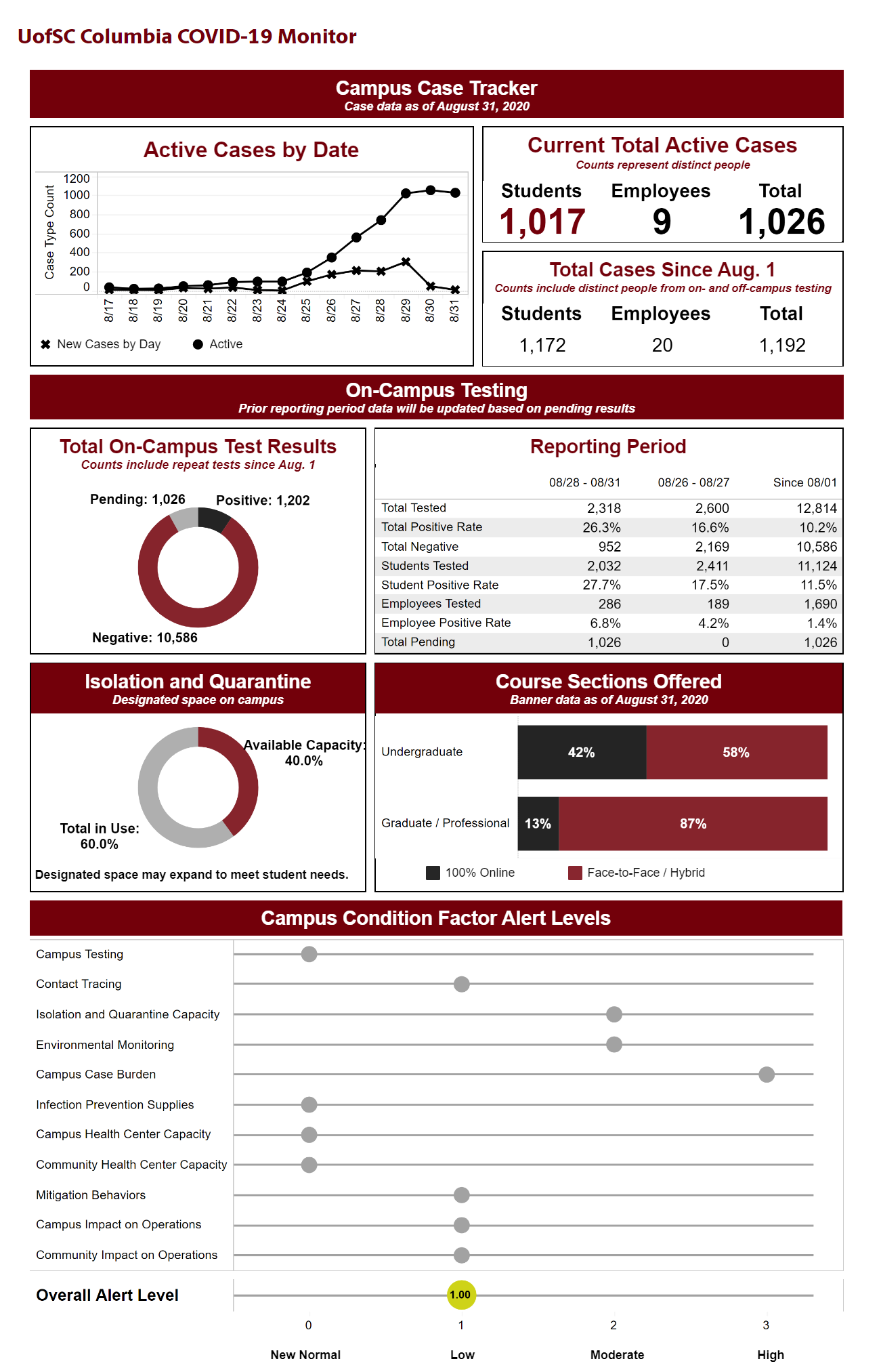University Pandemic Policies as Business Ethics Case Studies
Earlier this week, the University of South Carolina noted on its COVID-19 “dashboard” that 27.7% of the students tested for the virus were infected with it.
These figures were from testing conducted from August 28th through August 31st. In total, at the time, there were 1,192 active cases of COVID-19 (1,172 students and 20 employees). It’s not quite what a university wants to make the national news for.
The University of South Carolina invited students back to campus for the Fall 2020 term and is offering a mix of online, hybrid, and in-person courses. Should it have instead decided that all instruction should be online and not opened up the campus? That’s one question. Another is: What should the university do now? We could use some help! But perhaps more in line with the nature of this website is to observe that both of these questions would make for excellent topics in researching and teaching business ethics.
The university has, to its credit, been relatively transparent, publicizing a lot of relevant information and presenting it clearly. Here’s what the UofSC dashboard looks like:
In meetings with faculty and staff, UofSC President Bob Caslen has admitted that numbers like these are “unacceptable.” The question is what to do about them. Figuring that out means identifying what of importance is at stake, what our options are, what the short and long term effects of choosing different options would be, who within and outside of the university community is affected by those options, what those affected are entitled to, what if anything the university owes anyone for decisions that led to the current problems, moral and legal constraints on courses of action, and so on. There are so many factors here for ethicists to take into consideration, and in addition to its complexity, the problem is urgent. Simplistic solutions (send everyone home!), gripes about what should have been done (they should never have opened!), and wishes for a different type of political or economic system (damn capitalism!) are unlikely to be helpful.
How universities handle this crisis will certainly be among the central case studies of future business ethics courses and texts. Business ethicists, this is your moment.
Discussion—and suggestions—welcome.





I mostly don’t think any universities should have opened anywhere, but totally agree that “well, we did, so now what?” is the next big ethical conundrum.
One thing that’s worth noting is hardly anywhere has any pre-defined conception of what “winning” or “losing” even looks like. For example, schools could have come out with rules like “if x% of the students test positive, then [whatever].” I can see a few reasons why they’d be resistant to this: (1) whatever x% is, it’s probably arbitrary; and (2) there are reasons to think we might want a more holistic approach than something so reductionisitic.
In favor of the holistic approach are things like: where are we at on the vaccine?; is it a rural or urban campus?; what’s going on in the rest of the state?; where are we on available hospital beds; and probably a bunch of other things. But while it certainly seems relevant to consider that sort of stuff, it also makes things operationally intractable. And so we just end up with places making decisions under decision-architectures that haven’t been well formulated.
The other big ethics thing here is something like “collateral damage”–say these infections are foreseen but unintended. How many infections is it “worth” to keep a university running? How do we even think through how to answer that? We can use other concepts, like “proportionality”: we should keep the universities open so long as costs don’t swamp the benefits, but what are the benefits of the universities being open in the first place? And to whom do those benefits accrue? I’m really skeptical of there being benefits at all–and if there are any, that they’re not accruing equitably to all the stakeholders–so I’d still want to set those thresholds for continuing operations to be pretty restrictive.
One sub-question here is of course what kinds of metrics to use and how to present them. The dashboard above, for example, is an artifact that does some work (sorry: I read too much STS). In particular the overall “low” level on the bottom slider is presumably generated by some sort of aggregation of the previous metrics, but we don’t know how they’re weighted. Similarly we don’t know how “case burden” is calculated, only that it’s “high.” But an inquiring mind might want to know why if both the case burden and the capacity to quarantine are above “low,” the overall burden is low.
Similarly, campus testing is “new normal.” Well, ok. Beyond not knowing what that means, a 27% positive rate shows that the amount of testing is *not adequate* to understand how much Covid is on campus (epidemiologists seem to have settled on around 5% as a desirable target here, and NC is using the test positivity rate as part of its calculation of when/how to reopen). So normal is inadequate?
My view – channeling the spirit of Joseph Heath – is that this is an example of a collective action problem. Every university probably knew it was foolish to open, but couldn’t not do so for fear of losing “business” to “competitors”. In the UK (and I guess the US, though perhaps the model is different there), govt intervention to prevent the plans to open would have been the way to go. Student numbers would have held up as it’s not like there’s a lot of enticing employment opportunities open to 18 year olds. But alas, we have a useless govt and the competitive education market is ill suited to dealing with such problems. So I’m not optimistic that any sensible decisions will be taken in the immediate future.
TLDR: damn capitalism AND useless govt.